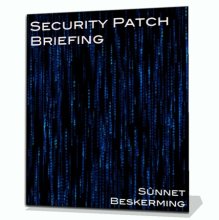Dealing With Disasters - Not Being Afraid of a Sick Pig
A holistic approach to Information Security takes into consideration more than just electronic assets and elements. Social engineers, for example, rely upon exploiting people to gain access to what they are after. Another non-electronic element is Disaster Recovery and all of the associated crisis management that comes with it.
Winter is less than a week away for countries in the Southern Hemisphere, and along with the cold weather comes cold and flu season. Every year companies are placed under strain as whole sections of their workforce fall ill or are forced to take time off work to care for family members who are ill. This can lead to real losses of efficiency and productivity, but it is next to impossible to actually predict who is more likely to become ill, and what areas of business are going to suffer the most.
This year swine flu has seen more people than ever concerned about the slightest sniffle and cough and, so far, it hasn't affected large numbers worldwide to differentiate it significantly from normal influenza. Widespread publicity and government action to help mitigate the spread of affected individuals has many hoping that it is nothing more than a scare, and will not be the next Spanish Influenza (which was also a swine flu originating from the Americas). The low percentages of people infected, compared to the overall population, seems to support this argument. With the ability for an infectious person to travel around the globe before symptoms present, the slow spread of swine flu is further reinforcement for those hoping that it is not going to be a significant problem.
That has been the case up to now. With the flu season getting into full swing in the Southern Hemisphere, the doubling of swine flu cases overnight in Australia might be enough to give people some pause. Even though the total number of infected people is less than 150 (at the time of writing), the scare amongst some people is that this could be the first real sign of an exponential growth in the numbers of infected people. Others are less concerned.
Whether the rate of growth is exponential or linear doesn't really matter, a range of actions are going on in the community that are going to force businesses to begin looking at maintaining operations on reduced staffing levels. Various schools have been closed (and some are now reopening), there are people and families all over the country entering into a 'stay-at-home' isolation, and there is the chance that passengers on a cruise ship in Australian waters will be all placed into isolation.
If you or your workplace don't have a Disaster Recovery plan in place, then now would be a good time to look at making one. The biggest problem that this flu season presents, even if swine flu is no worse than a normal flu, is in dragging away a significant percentage of employees for a week to two weeks at a time, even if they are completely healthy.
Can your business continue to operate with 10%, 20%, 30% of employees away from work? Are there any localised points of vulnerability where the loss of one or two key individuals will bring productivity to a halt? Can your business survive on limited or no turnover if all productivity is ceased? Can your healthy employees at home still carry out work remotely? If so, how secure is the interconnect with the workplace? Are you going to risk the security of your data and business to continue operations because you can't otherwise afford the productivity loss?
The answers to questions such as these should form the core of your Disaster Recovery plan. Once the plan is established, you should review it regularly to ensure the recovery actions and assessed risks are still relevant. The start of flu season is as good a time as any to do so.
A doubling of confirmed swine flu cases in 24 hours is significant, even with small overall numbers of infected individuals. The world will now be watching Australia to see what could be to come for the major population centres in the Northern hemisphere when winter next rolls around.
If it was possible to accurately predict and plan for events taking place, then there would be no need for Disaster Recovery planning, but by being prepared for disastrous events and having a plan to recover from them it means that you and your business will survive with more resilience once normal operations are resumed (and they will be resumed more quickly). Get some benefit from the increased public awareness of swine flu and take the opportunity to get your Disaster Recovery plans sorted out before you actually need to implement them.
28 May 2009
Social bookmark this page at eKstreme.
Alternatively, Bookmark or Share via AddThis
Do you like how we cover Information Security news? How about checking out our company services, delivered the same way our news is.
Let our Free OS X Screen Saver deliver the latest security alerts and commentary to your desktop when you're not at your system.
Comments will soon be available for registered users.
 Subscribe to our feed.
Subscribe to our feed.